辽宁省沈阳市东北育才学校2017_2018学年高一英语下学期第二阶段考试试题
- 格式:docx
- 大小:23.78 KB
- 文档页数:7
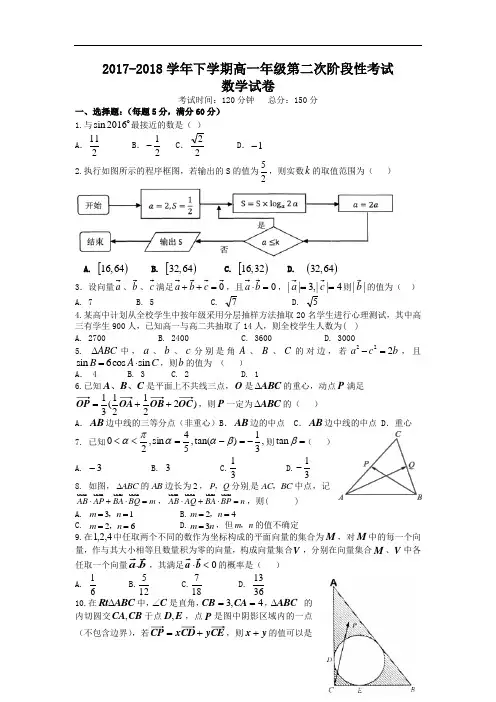
2017-2018学年下学期高一年级第二次阶段性考试数学试卷考试时间:120分钟 总分:150分一、选择题:(每题5分,满分60分) 1.与sin 2016最接近的数是( )A .211 B .21- C .22D .1- 2.执行如图所示的程序框图,若输出的S 的值为52,则实数k 的取值范围为( )A. [)16,64B.[)32,64 C. [)16,32 D. ()32,64 3.设向量a 、b 、c 满足0=++c b a ,且0=⋅b a ,4||,3||==c a 则||b 的值为( )A. 7B. 5C. 7D. 54.某高中计划从全校学生中按年级采用分层抽样方法抽取20名学生进行心理测试,其中高三有学生900人,已知高一与高二共抽取了14人,则全校学生人数为( ) A. 2700 B. 2400 C. 3600 D. 30005. ABC ∆中,a 、b 、c 分别是角A 、B 、C 的对边,若222a c b -=,且s i n 6c o s s i n B A C =⋅,则b 的值为 ( ) A . 4 B. 3 C. 2 D. 16.已知C B A 、、是平面上不共线三点,O 是ABC ∆的重心,动点P 满足)22121(31++=,则P 一定为ABC ∆的( )A .AB 边中线的三等分点(非重心)B .AB 边的中点C .AB 边中线的中点D .重心7. 已知,31)tan(,54sin ,20-=-=<<βααπα则=βtan ( )A. 3-B. 3C.31D.31-8. 如图,ABC ∆的AB 边长为2,P Q ,分别是AC BC ,中点,记AB AP BA BQ m ⋅+⋅=,AB AQ BA BP n ⋅+⋅=,则( )A. 31m n ==,B.24m n ==,C. 26m n ==,D.3m n =,但m n ,的值不确定9.在4,2,1中任取两个不同的数作为坐标构成的平面向量的集合为M ,对M 中的每一个向量,作与其大小相等且数量积为零的向量,构成向量集合V ,分别在向量集合M 、V 中各任取一个向量,其满足0<⋅的概率是( )A.61 B.125 C.187 D. 361310.在ABC Rt ∆中,C ∠是直角,4,3==CA CB ,ABC ∆ 的内切圆交CB CA ,于点ED ,,点P 是图中阴影区域内的一点(不包含边界),若y x +=,则y x +的值可以是A.1B.2C.4D.8 11.下列四个:①函数|1cos 2|)(2-=x x f 的最小正周期是π; ②函数)232sin(π+=x y 是偶函数; ③函数x b x a x f cos sin )(-=的图象的一条对称轴为直线4π=x ,则0=+b a ;④函数)4sin()(π+=x x f 在]2,2[ππ-上单调递增。
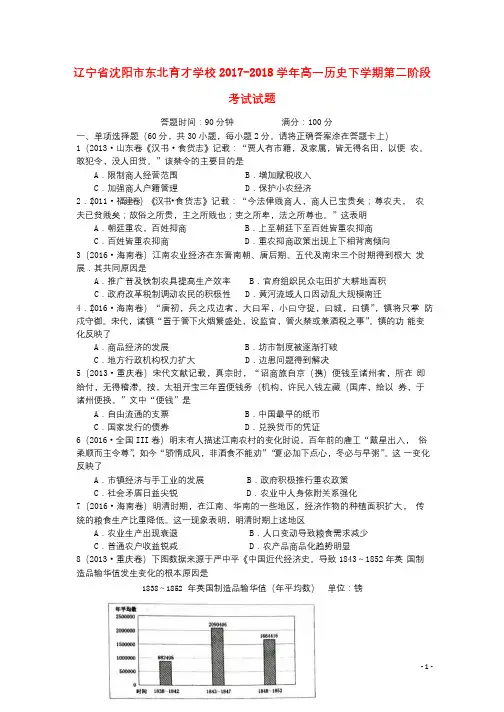
辽宁省沈阳市东北育才学校2017-2018学年高一历史下学期第二阶段考试试题答题时间:90分钟满分:100分一、单项选择题(60分,共30小题,每小题2分。
请将正确答案涂在答题卡上)1(2013·山东卷《汉书·食货志》记载:“贾人有市籍,及家属,皆无得名田,以便农。
敢犯令,没人田货。
”该禁令的主要目的是A.限制商人经营范围B.增加赋税收入C.加强商人户籍管理D.保护小农经济2.(2011·福建卷)《汉书•食货志》记载:“今法律贱商人,商人已宝贵矣;尊农夫,农夫已贫贱矣;故俗之所贵,主之所贱也;吏之所卑,法之所尊也。
”这表明A.朝廷重农,百姓抑商B.上至朝廷下至百姓皆重农抑商C.百姓皆重农抑商D.重农抑商政策出现上下相背离倾向3(2016·海南卷)江南农业经济在东晋南朝、唐后期、五代及南宋三个时期得到根大发展.其共同原因是A.推广普及铁制农具提高生产效率B.官府组织民众屯田扩大耕地面积C.政府改革税制调动农民的积极性D.黄河流域人口因动乱大规模南迁4.(2016·海南卷)“唐初,兵之戍边者,大曰军,小曰守捉,曰城,曰镇”,镇将只掌防戍守御。
宋代,诸镇“置于管下火烟繁盛处,设监官,管火禁或兼酒税之事”。
镇的功能变化反映了A.商品经济的发展B.坊市制度被逐渐打破C.地方行政机构权力扩大D.边患问题得到解决5(2013·重庆卷)宋代文献记载,真宗时,“诏商旅自京(携)便钱至诸州者,所在即给付,无得稽滞。
按,太祖开宝三年置便钱务(机构,许民入钱左藏(国库,给以券,于诸州便换。
”文中“便钱”是A.自由流通的支票B.中国最早的纸币C.国家发行的债券D.兑换货币的凭证6(2016·全国III卷)明末有人描述江南农村的变化时说,百年前的雇工“戴星出入,俗柔顺而主令尊”,如今“骄惰成风,非酒食不能劝”“夏必加下点心,冬必与早粥”。
这一变化反映了A.市镇经济与手工业的发展B.政府积极推行重农政策C.社会矛盾日益尖锐D.农业中人身依附关系强化7(2016·海南卷)明清时期,在江南、华南的一些地区,经济作物的种植面积扩大,传统的粮食生产比重降低。
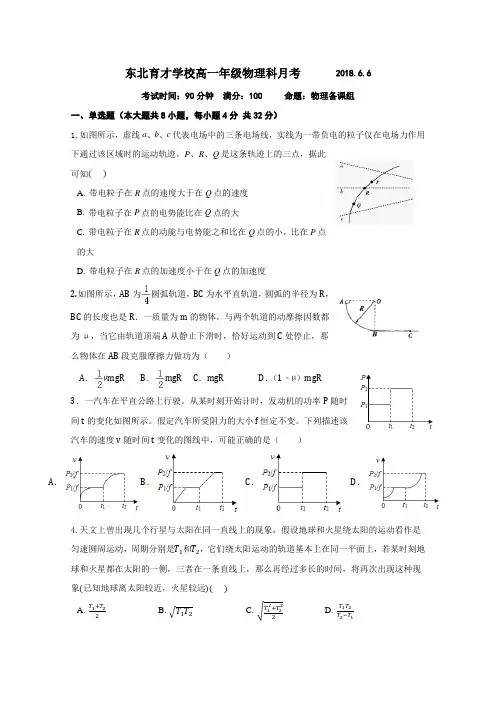
东北育才学校高一年级物理科月考 2018.6.6考试时间:90分钟满分:100 命题:物理备课组一、单选题(本大题共8小题,每小题4分共32分)1.如图所示,虚线a、b、c代表电场中的三条电场线,实线为一带负电的粒子仅在电场力作用下通过该区域时的运动轨迹,P、R、Q是这条轨迹上的三点,据此可知A. 带电粒子在R点的速度大于在Q点的速度B. 带电粒子在P点的电势能比在Q点的大C. 带电粒子在R点的动能与电势能之和比在Q点的小,比在P点的大D. 带电粒子在R点的加速度小于在Q点的加速度2.如图所示,AB为圆弧轨道,BC为水平直轨道,圆弧的半径为R,BC的长度也是R.一质量为m的物体,与两个轨道的动摩擦因数都为μ,当它由轨道顶端A从静止下滑时,恰好运动到C处停止,那么物体在AB段克服摩擦力做功为()A.µmgR B.mgR C.mgR D.(1﹣µ)mgR3.一汽车在平直公路上行驶。
从某时刻开始计时,发动机的功率P随时间t的变化如图所示。
假定汽车所受阻力的大小f恒定不变。
下列描述该汽车的速度v随时间t变化的图线中,可能正确的是()A. B.C.D.4.天文上曾出现几个行星与太阳在同一直线上的现象,假设地球和火星绕太阳的运动看作是匀速圆周运动,周期分别是和,它们绕太阳运动的轨道基本上在同一平面上,若某时刻地球和火星都在太阳的一侧,三者在一条直线上,那么再经过多长的时间,将再次出现这种现象已知地球离太阳较近,火星较远A. B. C. D.5.如图所示,一个可以看作质点的物体以一定的初速度沿水平面由A 点滑到B 点,摩擦力做功为W ;若该物体从C 点以一定的初速度沿两个斜面滑到D 点,两斜面用光滑小圆弧连接,摩擦力做功为W ;已知该物体与各接触面的动摩擦因数均相同,则( )A.W >WB.W =WC.W <WD.无法确定W 和W 的大小关系。
6.如图所示,三角形木块A 质量为M ,置于光滑水平面上,底边长a ,在其顶部有一三角形小木块B 质量为m ,其底边长b ,若B 从顶端由静止滑至底部,则木块后退的距离为( )A .B .C .D . 7.如图所示的xOy 坐标系中,x 轴上固定一个点电荷Q ,y 轴上固定一根光滑绝缘细杆 细杆的下端刚好在坐标原点D 处 ,将一个套在杆上重力不计的带电圆环 视为质点 从杆上P 处由静止释放,圆环从O 处离开细杆后恰好绕点电荷Q 做圆周运动 下列说法正确的是A. 圆环沿细杆从P 运动到O 的过程中,加速度一直增大B. 圆环沿细杆从P 运动到O 的过程中,速度先增大后减小C. 增大圆环所带的电荷量其他条件不变,圆环离开细杆后仍然能绕点电荷做圆周运动D. 将圆环从杆上P 的上方由静止释放,其他条件不变,圆环离开细杆后仍然能绕点电荷做圆周运动8.如图所示,足够长的光滑斜面固定在水平面上,轻质弹簧与A 、B 物块相连,A 、C 物块由跨过光滑小滑轮的轻绳连接。
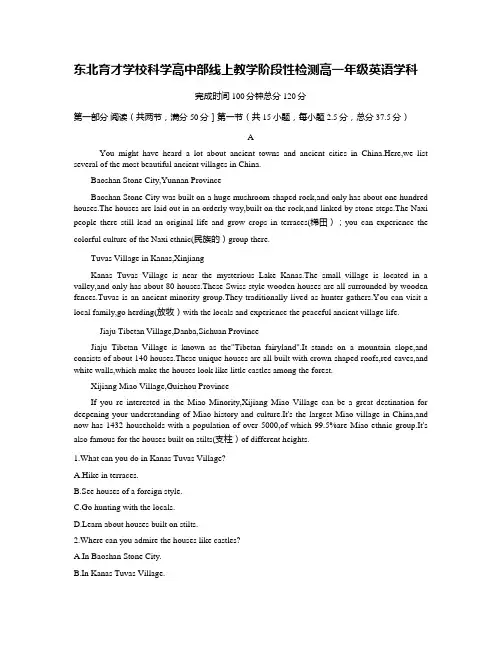
东北育才学校科学高中部线上教学阶段性检测高一年级英语学科完成时间100分钟总分120分第一部分阅读(共两节,满分50分]第一节(共15小题,每小题2.5分,总分37.5分)AYou might have heard a lot about ancient towns and ancient cities in China.Here,we list several of the most beautiful ancient villages in China.Baoshan Stone City,Yunnan ProvinceBaoshan Stone City was built on a huge mushroom-shaped rock,and only has about one hundred houses.The houses are laid out in an orderly way,built on the rock,and linked by stone steps.The Naxi people there still lead an original life and grow crops in terraces(梯田);you can experience thecolorful culture of the Naxi ethnic(民族的)group there.Tuvas Village in Kanas,XinjiangKanas Tuvas Village is near the mysterious Lake Kanas.The small village is located in a valley,and only has about 80 houses.These Swiss-style wooden houses are all surrounded by wooden fences.Tuvas is an ancient minority group.They traditionally lived as hunter-gathers.You can visit a local family,go herding(放牧)with the locals and experience the peaceful ancient village life.Jiaju Tibetan Village,Danba,Sichuan ProvinceJiaju Tibetan Village is known as the"Tibetan fairyland".It stands on a mountain slope,and consists of about 140 houses.These unique houses are all built with crown-shaped roofs,red eaves,and white walls,which make the houses look like little castles among the forest.Xijiang Miao Village,Guizhou ProvinceIf you re interested in the Miao Minority,Xijiang Miao Village can be a great destination for deepening your understanding of Miao history and culture.It's the largest Miao village in China,and now has 1432 households with a population of over 5000,of which 99.5%are Miao ethnic group.It's also famous for the houses built on stilts(支柱)of different heights.1.What can you do in Kanas Tuvas Village?A.Hike in terraces.B.See houses of a foreign style.C.Go hunting with the locals.D.Learn about houses built on stilts.2.Where can you admire the houses like castles?A.In Baoshan Stone City.B.In Kanas Tuvas Village.C.In Jiaju Tibetan Village.D.In Xijiang Miao Village.3.What can we infer about the villages mentioned in the text?A.They remained secret to the outside world in the past.B.They were originally built to defend their homeland.C.They are still cut off and difficult to access nowadays.D.They are the ethnic villages with unique architecture.BI was in the seventh grade,and we had moved to New Jersey in November.By then,everyone already had had their own friends,and no one wanted to talk to a new girl.To make things worse,they put me in"Section L".I found out later that everyone called Section L"Loserville".It was sort of an open secret that it was the section for troublemakers and not-so-smart kids.When I found out,I wanted to scream.I had always been a good student and had amazing friends,and now everyone thought I was a loser!I did text my friends in Illinois almost every night,especially my best friend,Ana.At first my friends wanted to hear all about it.But then some stopped texting back once I said something about how miserable I was.One night when I was texting with Ana,I complained about another friend who had just done that.Ana's texts came really fast for the next few minutes and they surprised me.She said that she was tired of hearing about how bad everything was in New Jersey,too.She said she did not want to hurt my feelings but that I needed to stop feeling so sorry for myself all the time,I had to try to make things better.The next day,I thought a lot about what Ana had said.She was right!I wish I could say that everything changed overnight after that,but it didn't.I was still stuck in"Loserville", and some people were still mean to me,even though I tried to just stay out of their way.But what did change was me-I stopped feeling so sorry for myself and did something about making friends.I signed up to make sets for the school play.I met a lot of new people there,and suddenly I had friends to say hi to in the halls!I still miss Illinois sometimes,but life in New Jersey isn't so hard anymore.Even though I couldn't change my situation,I could change my attitude-and that made all the difference.4."Loserville"is a section forA.failuresB.good studentsC.class secretsD.newcomers5.The writer complained all the time in the new environment becauseA.Ana didn't text back to herB.her friends hurt her feelingsC.she was unfairly treatedD.she was a good student6.What made a difference in changing the situation?A.She went back to Illinois.B.She ended friendship with Ana.C.She fought back with her classmates.D.She began to make friends with others.7.The best title for the passage can be_sting FriendshipB.An Incidence at SchoolC.Say Goodbye to"Loserville"D.Unhappiness in"Loserville"CMoscow city authorities have begun using comics(漫画)with characters from Russian fairy tales to explain to migrants(移民)how they should behave.They say a 100-page guide is needed to"keep a positive image"of the city and could help reduce"tensions"between natives and migrants.But critics have pointed out that foreign migrants and natives may be regarded as antagonists in the manual(手册)。
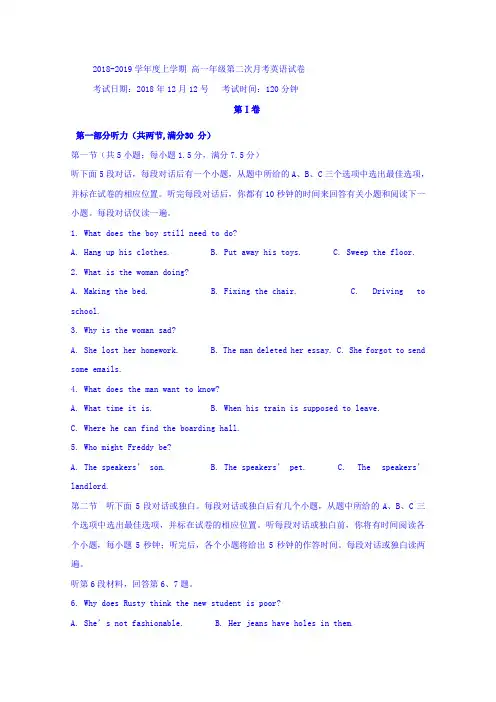
2018-2019学年度上学期高一年级第二次月考英语试卷考试日期:2018年12月12号考试时间:120分钟第Ⅰ卷第一部分听力(共两节,满分30 分)第一节(共5小题;每小题1.5分,满分7.5分)听下面5段对话,每段对话后有一个小题,从题中所给的A、B、C三个选项中选出最佳选项,并标在试卷的相应位置。
听完每段对话后,你都有10秒钟的时间来回答有关小题和阅读下一小题。
每段对话仅读一遍。
1. What does the boy still need to do?A. Hang up his clothes.B. Put away his toys.C. Sweep the floor.2. What is the woman doing?A. Making the bed.B. Fixing the chair.C. Driving to school.3. Why is the woman sad?A. She lost her homework.B. The man deleted her essay.C. She forgot to send some emails.4. What does the man want to know?A. What time it is.B. When his train is supposed to leave.C. Where he can find the boarding hall.5. Who might Freddy be?A. The speakers’ son.B. The speakers’ pet.C. The spe akers’ landlord.第二节听下面5段对话或独白。
每段对话或独白后有几个小题,从题中所给的A、B、C三个选项中选出最佳选项,并标在试卷的相应位置。
听每段对话或独白前,你将有时间阅读各个小题,每小题5秒钟;听完后,各个小题将给出5秒钟的作答时间。
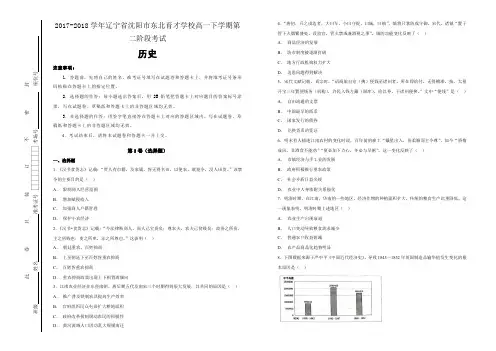
2017-2018学年辽宁省沈阳市东北育才学校高一下学期第二阶段考试 历史 注意事项: 1.答题前,先将自己的姓名、准考证号填写在试题卷和答题卡上,并将准考证号条形码粘贴在答题卡上的指定位置。
2.选择题的作答:每小题选出答案后,用2B 铅笔把答题卡上对应题目的答案标号涂黑,写在试题卷、草稿纸和答题卡上的非答题区域均无效。
3.非选择题的作答:用签字笔直接答在答题卡上对应的答题区域内。
写在试题卷、草稿纸和答题卡上的非答题区域均无效。
4.考试结束后,请将本试题卷和答题卡一并上交。
第I 卷(选择题) 一、选择题 1.《汉书食货志》记载:“贾人有市籍,及家属,皆无得名田,以便农。
敢犯令,没人田货。
”该禁令的主要目的是( ) A . 限制商人经营范围 B . 增加赋税收入 C . 加强商人户籍管理 D . 保护小农经济 2.《汉书•食货志》记载:“今法律贱商人,商人已宝贵矣;尊农夫,农夫已贫贱矣;故俗之所贵,主之所贱也;吏之所卑,法之所尊也。
”这表明( ) A . 朝廷重农,百姓抑商 B . 上至朝廷下至百姓皆重农抑商 C . 百姓皆重农抑商 D . 重农抑商政策出现上下相背离倾向 3.江南农业经济在东晋南朝、唐后期五代及南宋三个时期得到很大发展.其共同的原因是( ) A . 推广普及铁制农具提高生产效率 B . 官府组织民众屯田扩大耕地面积C . 政府改革税制调动农民的积极性D . 黄河流域人口因动乱大规模南迁4.“唐初,兵之戍边者,大曰军,小曰守捉,曰城,曰镇”,镇将只掌防戍守御。
宋代,诸镇“置于管下火烟繁盛处,设监官,管火禁或兼酒税之事”。
镇的功能变化反映了( ) A . 商品经济的发展 B . 坊市制度被逐渐打破 C . 地方行政机构权力扩大 D . 边患问题得到解决 5.宋代文献记载,真宗时,“诏商旅自京(携)便钱至诸州者,所在即给付,无得稽滞。
按,太祖开宝三年置便钱务(机构),许民入钱左藏(国库),给以券,于诸州便换。
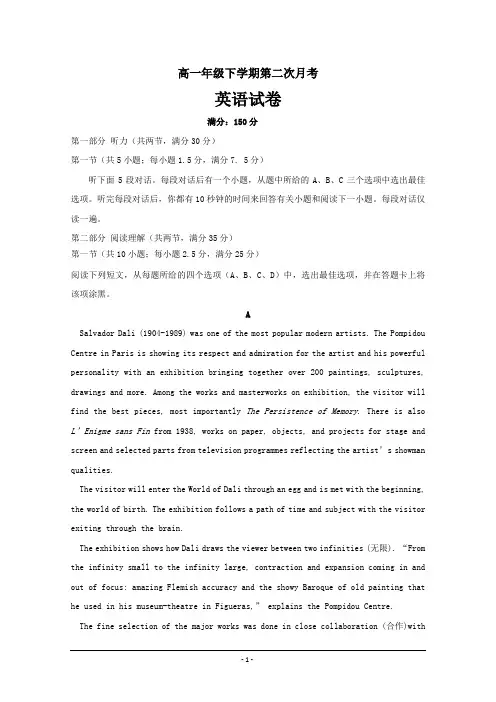
高一年级下学期第二次月考英语试卷满分:150分第一部分听力(共两节,满分30分)第一节(共5小题;每小题1.5分,满分7. 5分)听下面5段对话。
每段对话后有一个小题,从题中所给的A、B、C三个选项中选出最佳选项。
听完每段对话后,你都有10秒钟的时间来回答有关小题和阅读下一小题。
每段对话仅读一遍。
第二部分阅读理解(共两节,满分35分)第一节(共10小题;每小题2.5分,满分25分)阅读下列短文,从每题所给的四个选项(A、B、C、D)中,选出最佳选项,并在答题卡上将该项涂黑。
ASalvador Dali (1904-1989) was one of the most popular modern artists. The Pompidou Centre in Paris is showing its respect and admiration for the artist and his powerful personality with an exhibition bringing together over 200 paintings, sculptures, drawings and more. Among the works and masterworks on exhibition, the visitor will find the best pieces, most importantly The Persistence of Memory. There is also L’Enigme sans Fin from 1938, works on paper, objects, and projects for stage and screen and selecte d parts from television programmes reflecting the artist’s showman qualities.The visitor will enter the World of Dali through an egg and is met with the beginning, the world of birth. The exhibition follows a path of time and subject with the visitor exiting through the brain.The exhibition shows how Dali draws the viewer between two infinities (无限). “From the infinity small to the infinity large, contraction and expansion coming in and out of focus: amazing Flemish accuracy and the showy Baroque of old painting that he used in his museum-theatre in Figueras,” explains the Pompidou Centre.The fine selection of the major works was done in close collaboration (合作)withthe Museo Nacional Reina Sofia in Madrid, Spain, and with contributions from other institutions like the Salvador Dali Museum in St. Petersburg, Florida.21. Which of the following best describes Dali according to Paragraph 1?A. optimistic.B. productive.C. generous.D. traditional.22. What is Dali’s The Persistence of Memor y considered to be?A. One of his masterworks.B. A successful screen adaptation.C. An artistic creation for the stage.D. One of the best TV programmes.23. How are the exhibits arranged at the World of Dali?A. By popularity.B. By importance.C. By size and shape.D. By time and subject.24. What does the word “contributions” in the last paragraph refer to?A. artworks.B. projects.C. donations.D. documents.BA high-factor sunscreen(防晒霜)is generally expected to protect the skin from harmful rays, but it isn’t. A new research in this week's Nature shows that while factor 50 reduces the number of melanomas(黑瘤)and delays their occurrence, it can't prevent them. Melanomas are the most aggressive skin cancers. You have a higher risk if you have red or blond hair, fair skin, blue or green eyes, or sunburn easily, or if a close relative has had one. Melanomas are more common if you have periodic intense exposure to the sun. Other skin cancers are increasingly likely with long-term exposure.There is continuing debate as to how effective sunscreen is in reducing melanomas—the evidence is weaker than it is for preventing other types of skin cancer.A 2011 Australian study of 1,621 people found that people selected to apply sunscreen daily had half the rate of melanomas of people who used cream as needed. A second study, comparing 1,167 people with melanomas to 1,101 who didn't have the cancer, found that using sunscreen routinely, alongside other protection such as hats, long sleeves or staying in the shade, did give some protection. This study said other formsof sun protection—not sunscreen—seemed most beneficial. The study relied on people remembering what they had done over each decade of their lives, so it's not entirely reliable. But it seems reasonable to think sunscreen gives people a false sense of security in the sun.The good news is that a combination of sunscreen and covering up can reduce melanoma rates. So if there is a heat wave this summer, it would be best for us, too, to pull on a shirt, apply some sunscreen and put on a hat.25.What is people's common expectation of a high-factor sunscreen?A. It will delay the occurrence of skin cancer.B. It will protect them from sunburn.C. It will keep their skin smooth and fair.D. It will work for people of any skin color.26.What do we learn from the 2011Australian study of 1,621 people?A. Sunscreen should be applied alongside other protection measures.B. High-risk people benefit the most from the application of sunscreen.C. Irregular application of sunscreen does women more harm than good.D. Daily application of sunscreen helps reduce the incidence of melanomas.27.What does the author suggest to reduce melanoma rates?A. Using both covering up and sunscreen.B. Staying in the shade whenever possible.C. Using covering up instead of sunscreen.D. Applying the right amount of sunscreen.CThese days when someone says a computer has a bug in it, usually they mean that there's a problem with one of its programs. Maybe your computer has crashed when you are in the middle of a game, or you get an error message when you try to go to a website.But back in the early days of computers, a woman named Grace Hopper was part of the tear that discovered the very first computer bug.Hopper was a mathematician. She'd been hired by the navy to help program the new Mark II computer. The MarkⅡ’s job was to quickly solve the math problems ships andairplanes used to find in their way. The MarkⅡworked by reading instructions from a long strip of paper with holes in it. The computer translated the patterns of holes into the math problems it was supposed to solve.One afternoon in 1947 Hopper and her team were running a program. But the computer wasn’t giving them the right results. W hat could be wrong? They finally ended up taking the Mark II apart, looking for problems. What did they find?It was a dead moth(蛀虫)! The moth was blocking some of the holes on the paper strip----no wonder the computer didn't know what to do.Hopper knew that the term "bug" had been used before when there were problems with machines. But this was the first time a computer had ever had one. She thought it was funny that it was a real bug. Some people think Hopper was the first person to use the word "debug" to mean “get rid of the problems in a computer”.Her team kept a logbook of everything they did. They taped the moth onto the page for that day. The logbook, moth and all, is now in the Smithsonian Museum of American History in Washington D.C.Grace Hopper worked with computers her whole life. She was the first person to write a word-based computer language. This makes it easier for people to tell computers what to do. Some people called her "Grandma COBOL" after one of the computer languages she helped develop. But to most she was just “Amazing Grace”.28. What's the writer's purpose in writing paragraph 1?A. To tell us the main idea of the passage.B. To arouse the readers' interest to read on.C. To show the structure of the passage.D. To give a description of what a bug is.29. Which of the followings is true to describe Grace Hopper?A. She was the first expert to use the term “bug”.B. She was an astronomer to help work on the Mark II.C. She devoted all her life to work related to computers.D. She kept a record of all the computers on the Mark II.30. What is the text mainly about?A. The history of bug.B. The discovery of the first bug.C. Grace Hopper and her bug.D. Grace Hopper and the Mark II. 第二节(共5小题;每小题2分,满分10分)Do you know how to pick a good book you’ll really like? Here are some tips.Start with your interest. 31 . You can pick something that you love to read, not for school. They can be ancient martial (武术) arts, computers, or fashion design. You name it, there are books about it.Pick your type. Do you prefer fiction or nonfiction (or both)? Fiction books, like novels, can transport you to another world or help you imagine something beyond your own experience. Nonfiction books give you the who, what, when, and why of something. 32 . Many of them read like novels from start to finish.Read the description. The reviews and quotes on the back and inside covers of many books give you an idea of what the book is about. They can also help you pick future books, too. If you find a book you really like, take a minute to read the quotes and see which authors praised the book. 33 .Find a family favorite.Which book did your mother love best when she was at your age? 34 . Find out and give them a read — then you can share your thoughts about the book.Find a quiet place and make time for the book. 35 . You can put on some good music, get yourself some tea and let yourself be carried away by the book. You’ll see that time does fly when you’re reading something y ou love!A. How about your brothers and sisters?B. They tell stories using facts —but that doesn’t mean they’re boring.C. Reading is a good way to improve your English.D. Most reading is best enjoyed when you can concentrate on it.E. Often, they’ll ha ve similar styles and you might find books you like by those authors, too.F. So you should read as much as possible when you are free.G. Reading on your own isn’t like reading for school.第三部分英语知识运用(共两节,满分45分)第一节完型填空(共20题,每小题1.5分,满分30分)阅读下面短文,掌握其大意,然后从短文后各题所给的四个选项(A、B、C和D)中,选出最佳选项,并在答题纸上将该选项标号涂黑。
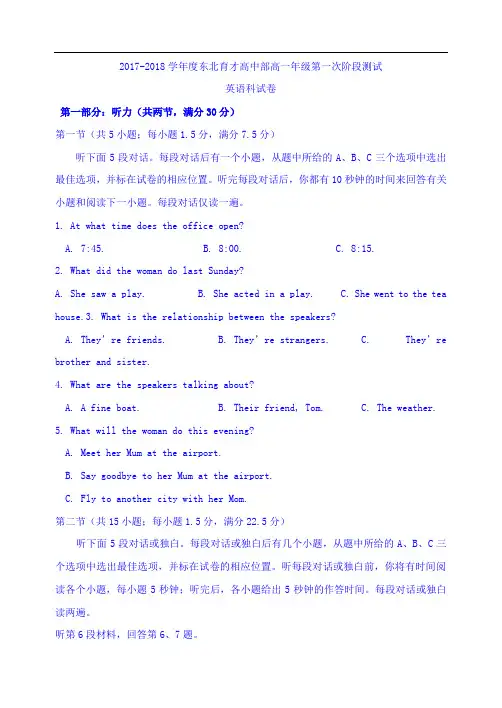
2017-2018学年度东北育才高中部高一年级第一次阶段测试英语科试卷第一部分:听力(共两节,满分30分)第一节(共5小题;每小题1.5分,满分7.5分)听下面5段对话。
每段对话后有一个小题,从题中所给的A、B、C三个选项中选出最佳选项,并标在试卷的相应位置。
听完每段对话后,你都有10秒钟的时间来回答有关小题和阅读下一小题。
每段对话仅读一遍。
1. At what time does the office open?A. 7:45.B. 8:00.C. 8:15.2. What did the woman do last Sunday?A. She saw a play.B. She acted in a play.C. She went to the tea house.3. What is the relationship between the speakers?A. They’re friends.B. They’re strangers.C. They’re brother and sister.4. What are the speakers talking about?A. A fine boat.B. Their friend, Tom.C. The weather.5. What will the woman do this evening?A. Meet her Mum at the airport.B. Say goodbye to her Mum at the airport.C. Fly to another city with her Mom.第二节(共15小题;每小题1.5分,满分22.5分)听下面5段对话或独白。
每段对话或独白后有几个小题,从题中所给的A、B、C三个选项中选出最佳选项,并标在试卷的相应位置。
听每段对话或独白前,你将有时间阅读各个小题,每小题5秒钟;听完后,各小题给出5秒钟的作答时间。
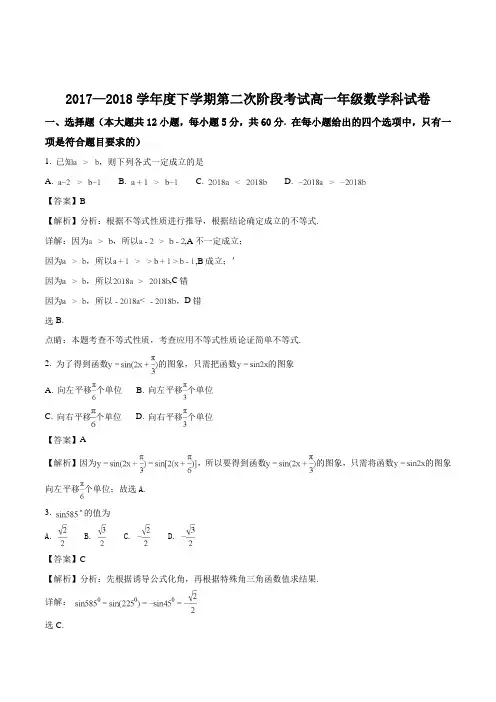
2017—2018学年度下学期第二次阶段考试高一年级数学科试卷一、选择题(本大题共12小题,每小题5分,共60分.在每小题给出的四个选项中,只有一项是符合题目要求的)1. 已知,则下列各式一定成立的是A. B. C. D.【答案】B【解析】分析:根据不等式性质进行推导,根据结论确定成立的不等式.详解:因为,所以,A不一定成立;因为,所以,B成立;’因为,所以,C错因为,所以< ,D错选B.点睛:本题考查不等式性质,考查应用不等式性质论证简单不等式.2. 为了得到函数的图象,只需把函数的图象A. 向左平移个单位B. 向左平移个单位C. 向右平移个单位D. 向右平移个单位【答案】A【解析】因为,所以要得到函数的图象,只需将函数的图象向左平移个单位;故选A.3. 的值为A. B. C. D.【答案】C【解析】分析:先根据诱导公式化角,再根据特殊角三角函数值求结果.详解:选C.点睛:本题考查诱导公式以及特殊角三角函数值,考查运用公式求解能力.4. 在四边形中,,,,则四边形的形状是A. 矩形B. 邻边不相等的平行四边形C. 菱形D. 梯形【答案】D详解:因为,,所以,所以AD//BC,AD BC因此四边形为梯形,选D.点睛:向量共线:(1),(2)(3)若,则三点共线(4)三点共线5. 在中,若,则的形状一定是A. 等腰直角三角形B. 直角三角形C. 等腰三角形D. 等边三角形【答案】C6. 某工厂第一年产量为A,第二年增长率为a,第三年的增长率为b,这两年的平均增长率为x,则A. B. C. D.【答案】B【解析】试题分析:由题意可知考点:不等式性质点评:本题利用不等式性质判定两数的大小,此不等式在求解最值方面应用广泛7. 设变量满足约束条件:的最大值为A. 10B. 8C. 6D. 4【答案】B【解析】分析:先作可行域,再确定直线变化范围,最后确定最大值.详解:作可行域,则直线过点B(-2,-2)时取最大值4,过点A(-2,2)时取最小值-8,因此最大值为8,选B.点睛:线性规划的实质是把代数问题几何化,即数形结合的思想.需要注意的是:一,准确无误地作出可行域;二,画目标函数所对应的直线时,要注意与约束条件中的直线的斜率进行比较,避免出错;三,一般情况下,目标函数的最大或最小值会在可行域的端点或边界上取得.8. 若是三角形中的最小内角,则的取值范围是A. B. C. D.【答案】D【解析】分析:先根据三角形最小内角得A范围,再根据辅助角公式化简,最后根据正弦函数性质求结果.详解:因为是三角形中的最小内角,所以,因为,,所以,因此选D.点睛:三角恒等变换的综合应用主要是将三角变换与三角函数的性质相结合,通过变换把函数化为的形式再借助三角函数图象研究性质,解题时注意观察角、函数名、结构等特征.9. 对一切实数x,若不等式x4+(a -1)x2+1≥0恒成立,则a的取值范围是A. a ≥-1B. a ≥0C. a ≤3D. a ≤1【答案】A【解析】分析:先令x2=t,再利用变量分离法转化为函数最值问题,最后根据基本不等式求最值得结果. 详解:令x2=t,因为t=0时1>0,所以此时当时,的最大值,因为,所以因此,选A.点睛:对于求不等式成立时的参数范围问题,在可能的情况下把参数分离出来,使不等式一端是含有参数的不等式,另一端是一个区间上具体的函数,这样就把问题转化为一端是函数,另一端是参数的不等式,便于问题的解决.但要注意分离参数法不是万能的,如果分离参数后,得出的函数解析式较为复杂,性质很难研究,就不要使用分离参数法.10. 函数的最小正周期为A. B. C. D.【答案】A【解析】分析:先化切为弦,再根据两角差余弦公式化简的基本三角函数,最后根据正切函数性质求周期. 详解:因为,所以最小正周期为,选A.点睛:三角恒等变换的综合应用主要是将三角变换与三角函数的性质相结合,通过变换把函数化为的形式再借助三角函数图象研究性质,解题时注意观察角、函数名、结构等特征.11. 已知平面内,,,且,则的最大值等于A. 13B. 15C. 19D. 21【答案】A【解析】分析:先根据条件建立直角坐标系,设B,C坐标,根据向量数量积得,最后根据基本不等式求最大值.详解:以A为坐标原点,AB所在直线为x轴建立直角坐标系,设所以,所以当且仅当时取等号,因此选A.点睛:以向量为载体求相关变量的取值范围,是向量与函数、不等式、三角函数、曲线方程等相结合的一类综合问题.通过向量的坐标运算,将问题转化为解方程、解不等式、求函数值域或直线与曲线位置关系,是解决这类问题的一般方法.12. 已知函数满足下列条件:①定义域为;②当时;③. 若关于x的方程恰有3个实数解,则实数k的取值范围是A. B. C. D.【答案】D【解析】分析:先根据条件确定函数图像,再根据过定点(1,0)的直线与图像关系确定实数k的取值范围.详解:因为,当时;所以可作函数在上图像,如图,而直线过定点A(1,0),根据图像可得恰有3个实数解时实数k的取值范围为,选D.点睛:对于方程解的个数(或函数零点个数)问题,可利用函数的值域或最值,结合函数的单调性、草图确定其中参数范围.从图象的最高点、最低点,分析函数的最值、极值;从图象的对称性,分析函数的奇偶性;从图象的走向趋势,分析函数的单调性、周期性等.二、填空题(本大题共4小题,每小题5分,共20分.将答案填在答题卡相应的位置上)13. 已知,,,则_________.【答案】【解析】试题分析:,∴.考点:平面向量的数量积.14. 函数的部分图象如图,则______.【答案】6【解析】试题分析:由图可知,,∴.考点:正切型函数的图象与平面向量的数量积运算.【方法点睛】本题主要考查了正切型函数的图象与平面向量的数量积运算,属于中档题.本题解答的关键观察图象发现分别是函数轴右侧的第一个零点和函数值为的点,即可求得的坐标,进而求得向量的坐标,根据平面向量数量积的坐标运算即可求得答案.15. 已知,,,则的最小值为________.【答案】4【解析】分析:先化为,再利用1的代换以及基本不等式求最值.详解:因为,所以所以当且仅当时取等号,因此的最小值为4.点睛:在利用基本不等式求最值时,要特别注意“拆、拼、凑”等技巧,使其满足基本不等式中“正”(即条件要求中字母为正数)、“定”(不等式的另一边必须为定值)、“等”(等号取得的条件)的条件才能应用,否则会出现错误.16. 设实数x,y满足,,则的取值范围是______.【答案】【解析】分析:先寻求,,三者等量关系,再根据不等式性质求取值范围.详解:因为,,所以.点睛:利用不等式性质求范围或值域问题,关键是构造或寻找量之间等量关系,再结合不等式性质求范围.三、解答题(本大题共6小题,共70分. 请在答题纸指定区域内作答,解答时应写出文字说明、证明过程或演算步骤)17. 已知,为锐角,且,.(1)求;(2)求.【答案】(1)(2)【解析】分析:(1) 先根据同角三角函数关系得,,,再根据两角和正弦公式化简得结果,(2) 根据二倍角公式得,,再根据两角和余弦公式得,最后根据范围求结果.详解:由于为锐角,,,∴,,,(2),,∴由于为锐角,∴,∴点睛:在求角的某个三角函数值时,应注意根据条件选择恰当的函数,尽量做到所选函数在确定角的范围内为一对一函数.①已知正切函数值,选正切函数;②已知正、余弦函数值,选正弦或余弦函数;若角的范围是,选正、余弦函数皆可;若角的范围是,选余弦函数较好;若角的范围为,选正弦函数较好18. 解关于的不等式.【答案】见解析【解析】分析:先讨论二次项系数为零的情况,再讨论开口向上与向下的情况,注意比较两根大小关系.详解:当m=0时,不等式化为x+2<0,解得解集为(﹣∞,﹣2);当m>0时,不等式等价于(x﹣)(x+2)>0,解得不等式的解集为(﹣∞,﹣2)∪(,+∞);当m<0时,不等式等价于(x﹣)(x+2)<0,若﹣<m<0,则<﹣2,解得不等式的解集为(,﹣2);若m=﹣,则=﹣2,不等式化为(x+2)2<0,此时不等式的解集为∅;若m<﹣,则>﹣2,解得不等式的解集为(﹣2,).综上,m=0时,不等式的解集为(﹣∞,﹣2);m>0时,不等式的解集为(﹣∞,﹣2)∪(,+∞);﹣<m<0时,不等式的解集为(,﹣2);m=﹣时,不等式的解集为∅;m<﹣时,不等式的解集为(﹣2,).点睛:解含参数不等式,一要讨论二次型系数为零的情况,二要讨论根有无情况,三要讨论根大小情况.19. 已知A(2,0),B(0,2),,O为坐标原点.(1)=-,求sin 2θ的值;(2)若=,且θ∈(-π,0),求与的夹角.【答案】(1);(2)【解析】分析:(1) 先根据向量数量积得sin θ+cos θ值,再平方得结果,(2)先根据向量的模得cos θ,即得C点坐标,再根据向量夹角公式求结果.详解:(1)∵=(cos θ,sinθ)-(2,0)=(cos θ-2,sin θ),=(cos θ,sin θ)-(0,2)=(cos θ,sin θ-2),=cos θ(cos θ-2)+sin θ(sin θ-2)=cos2θ-2cos θ+sin2θ-2sin θ=1-2(sin θ+cos θ)=-∴sin θ+cos θ=,∴1+2sin θcos θ=,∴sin 2θ=-1=-.(2)∵=(2,0),=(cos θ,sin θ),∴+=(2+cos θ,sin θ),∵|+|=,所以4+4cos θ+cos2θ+sin2θ=7,∴4cos θ=2,即cos θ=.∵-π<θ<0,∴θ=-,又∵=(0,2),=,∴cos〈,〉=,∴〈,〉=.点睛:向量的平行、垂直、夹角、数量积等知识都可以与三角函数进行交汇.对于此类问题的解决方法就是利用向量的知识将条件转化为三角函数中的“数量关系”,通过解三角求得结果.20. 位于A处的雷达观测站,发现其北偏东45°,与相距20海里的B处有一货船正以匀速直线行驶,20分钟后又测得该船只位于观测站A北偏东的C处,.在离观测站A的正南方某处E,.(1)求;(2)求该船的行驶速度v(海里/小时).【答案】(1);(2)【解析】分析:(1) 先根据同角三角函数关系得,再根据,并利用两角差余弦公式得结果,(2)根据余弦定理求AC,再除以时间得速度.详解:(1)(2)利用余弦定理该船以匀速直线行驶了20分钟的路程为海里,该船的行驶速度(海里/小时)点睛:解实际问题中的三角形问题,多为边和角的求值问题,这就需要根据正、余弦定理结合已知条件灵活转化边和角之间的关系,从而达到解决问题的目的.21. 在平面直角坐标系中,O为坐标原点,M为平面上任一点,A,B,C三点满足.(1)求的值;(2)已知A(1,sinx)、B(1+sinx,sinx),M(1+sinx,sinx),x∈(0,π),且函数的最小值为,求实数m的值.【答案】(1)3;(2)【解析】分析:(1) 先化简得,即得,进而得结果,(2)根据向量数量积以及向量的模化简函数解析式得f(x)=sin2x+2msinx+1,再根据对称轴与定义区间位置关系讨论最小值取法,最后根据最小值求m值.详解:(1)解:由=+,得﹣=2(﹣),∴=2,且、有公共点C,∴A,B,C三点共线,如图所示;∴===3;(2)A(1,sinx)、B(1+sinx,sinx),M(1+sinx,sinx),x∈(0,π),∴=(1,sinx)=(1+sinxsinx)=(sinx0)∴函数f(x)=•+(2m﹣)•||=(1+sinx)+sin2x+(2m﹣)•sinx=sin2x+2msinx+1;设sinx=t,∵x∈(0,π),∴t∈(0,1),∴y=t2+2mt+1=(t+m)2+1﹣m2;讨论﹣m<0即m>0时,此时y没有最小值;当0≤﹣m≤1即﹣1≤m≤0时,当t=﹣m有y min=1﹣m2=,解得m=﹣;当﹣m>1即m<﹣1时,此时y没有最小值;综上,得m=﹣.点睛:向量的平行、垂直、夹角、模、数量积等知识都可以与三角函数进行交汇.对于此类问题的解决方法就是利用向量的知识将条件转化为三角函数中的“数量关系”,再根据三角函数知识求对应函数性质.。
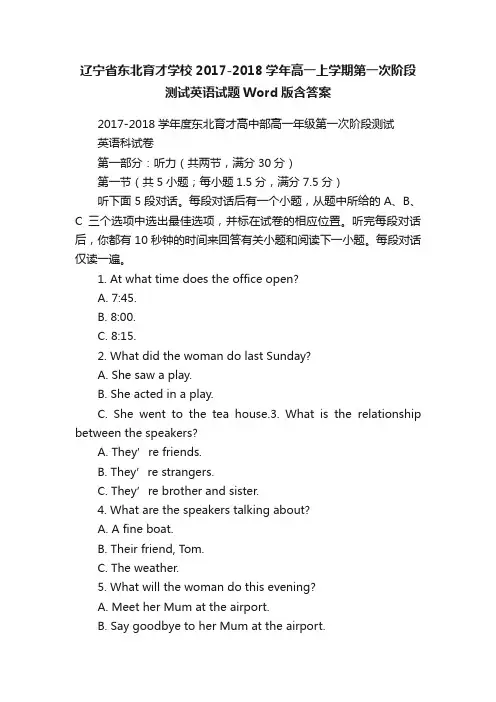
辽宁省东北育才学校2017-2018学年高一上学期第一次阶段测试英语试题Word版含答案2017-2018学年度东北育才高中部高一年级第一次阶段测试英语科试卷第一部分:听力(共两节,满分30分)第一节(共5小题;每小题1.5分,满分7.5分)听下面5段对话。
每段对话后有一个小题,从题中所给的A、B、C三个选项中选出最佳选项,并标在试卷的相应位置。
听完每段对话后,你都有10秒钟的时间来回答有关小题和阅读下一小题。
每段对话仅读一遍。
1. At what time does the office open?A. 7:45.B. 8:00.C. 8:15.2. What did the woman do last Sunday?A. She saw a play.B. She acted in a play.C. She went to the tea house.3. What is the relationship between the speakers?A. They’re friends.B. They’re strangers.C. They’re brother and sister.4. What are the speakers talking about?A. A fine boat.B. Their friend, Tom.C. The weather.5. What will the woman do this evening?A. Meet her Mum at the airport.B. Say goodbye to her Mum at the airport.C. Fly to another city with her Mom.第二节(共15小题;每小题1.5分,满分22.5分)听下面5段对话或独白。
每段对话或独白后有几个小题,从题中所给的A、B、C三个选项中选出最佳选项,并标在试卷的相应位置。
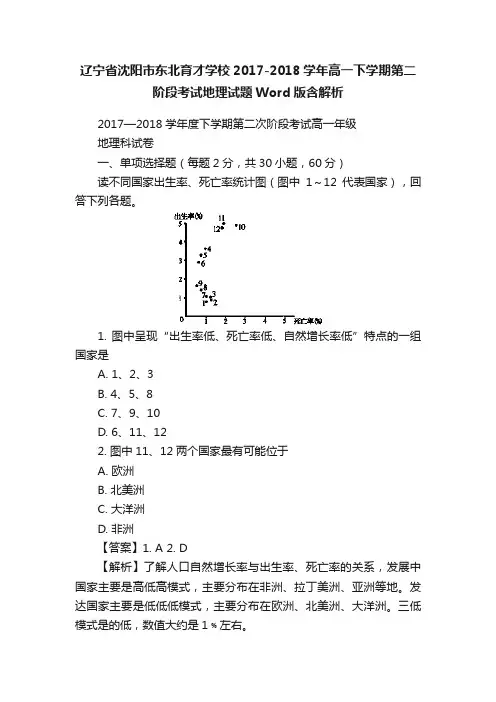
辽宁省沈阳市东北育才学校2017-2018学年高一下学期第二阶段考试地理试题Word版含解析2017—2018学年度下学期第二次阶段考试高一年级地理科试卷一、单项选择题(每题2分,共30小题,60分)读不同国家出生率、死亡率统计图(图中1~12代表国家),回答下列各题。
1. 图中呈现“出生率低、死亡率低、自然增长率低”特点的一组国家是A. 1、2、3B. 4、5、8C. 7、9、10D. 6、11、122. 图中11、12两个国家最有可能位于A. 欧洲B. 北美洲C. 大洋洲D. 非洲【答案】1. A 2. D【解析】了解人口自然增长率与出生率、死亡率的关系,发展中国家主要是高低高模式,主要分布在非洲、拉丁美洲、亚洲等地。
发达国家主要是低低低模式,主要分布在欧洲、北美洲、大洋洲。
三低模式是的低,数值大约是1﹪左右。
1. 图中呈现“出生率低、死亡率低、自然增长率低”特点的一组国家,在图中的出生率、死亡率约是1﹪左右,可以判断是1、2、3国家,A对。
4、5国家死亡率高,B错。
9、10 、6、11、12国家出生率高,C、D错。
2. 根据图中数值,图中11、12两个国家是高出生率,低死亡率,高自然增长率,说明是发展中国家,最有可能位于非洲,D对。
欧洲、北美洲、大洋洲主要是发达国家,出生率低,A、B、C错。
读山西、内蒙古和河北局部图,完成下列各题。
3. 按人口迁移方向划分,图中②各表示哪种迁移类型A. 农村到农村B. 农村到城市C. 城市到乡村D. 城市到城市4. ③迁移方式可能会使A. 内蒙古经济地区经济发展B. 太原劳动力短缺C. 西黄村劳动力短缺D. 西黄村经济发展5. 引起图中③人口迁移的主要原因可能是A. 自然生态环境原因B. 经济原因C. 社会文化原因D. 政治原因【答案】3. A 4. C 5. B【解析】3. 图中②为从刘家会到窑沟,是从农村到农村的人口迁移,选A。
4. 图中③迁移方式是从农村到城市的人口迁移,迁入地为太原市,可能会促进太原经济发展;弥补太原劳动力短缺;但对迁出地西黄村而言会导致青壮年劳动力短缺,对西黄村经济发展带来不利影响,据此选C。
2017—2018学年度下学期第二次阶段考试高一年级数学科试卷一、选择题(本大题共12小题,每小题5分,共60分.在每小题给出的四个选项中,只有一项是符合题目要求的)1. 已知,则下列各式一定成立的是A. B. C. D.【答案】B【解析】分析:根据不等式性质进行推导,根据结论确定成立的不等式.详解:因为,所以,A不一定成立;因为,所以,B成立;’因为,所以,C错因为,所以< ,D错选B.点睛:本题考查不等式性质,考查应用不等式性质论证简单不等式.2. 为了得到函数的图象,只需把函数的图象A. 向左平移个单位B. 向左平移个单位C. 向右平移个单位D. 向右平移个单位【答案】A【解析】因为,所以要得到函数的图象,只需将函数的图象向左平移个单位;故选A.3. 的值为A. B. C. D.【答案】C【解析】分析:先根据诱导公式化角,再根据特殊角三角函数值求结果.详解:选C.点睛:本题考查诱导公式以及特殊角三角函数值,考查运用公式求解能力.4. 在四边形中,,,,则四边形的形状是A. 矩形B. 邻边不相等的平行四边形C. 菱形D. 梯形【答案】D详解:因为,,所以,所以AD//BC,AD BC因此四边形为梯形,选D.点睛:向量共线:(1),(2)(3)若,则三点共线(4)三点共线5. 在中,若,则的形状一定是A. 等腰直角三角形B. 直角三角形C. 等腰三角形D. 等边三角形【答案】C6. 某工厂第一年产量为A,第二年增长率为a,第三年的增长率为b,这两年的平均增长率为x,则A. B. C. D.【答案】B【解析】试题分析:由题意可知考点:不等式性质点评:本题利用不等式性质判定两数的大小,此不等式在求解最值方面应用广泛7. 设变量满足约束条件:的最大值为A. 10B. 8C. 6D. 4【答案】B【解析】分析:先作可行域,再确定直线变化范围,最后确定最大值.详解:作可行域,则直线过点B(-2,-2)时取最大值4,过点A(-2,2)时取最小值-8,因此最大值为8,选B.点睛:线性规划的实质是把代数问题几何化,即数形结合的思想.需要注意的是:一,准确无误地作出可行域;二,画目标函数所对应的直线时,要注意与约束条件中的直线的斜率进行比较,避免出错;三,一般情况下,目标函数的最大或最小值会在可行域的端点或边界上取得.8. 若是三角形中的最小内角,则的取值范围是A. B. C. D.【答案】D【解析】分析:先根据三角形最小内角得A范围,再根据辅助角公式化简,最后根据正弦函数性质求结果. 详解:因为是三角形中的最小内角,所以,因为,,所以,因此选D.点睛:三角恒等变换的综合应用主要是将三角变换与三角函数的性质相结合,通过变换把函数化为的形式再借助三角函数图象研究性质,解题时注意观察角、函数名、结构等特征.9. 对一切实数x,若不等式x4+(a -1)x2+1≥0恒成立,则a的取值范围是A. a ≥-1B. a ≥0C. a ≤3D. a ≤1【答案】A【解析】分析:先令x2=t,再利用变量分离法转化为函数最值问题,最后根据基本不等式求最值得结果.详解:令x2=t,因为t=0时1>0,所以此时当时,的最大值,因为,所以因此,选A.点睛:对于求不等式成立时的参数范围问题,在可能的情况下把参数分离出来,使不等式一端是含有参数的不等式,另一端是一个区间上具体的函数,这样就把问题转化为一端是函数,另一端是参数的不等式,便于问题的解决.但要注意分离参数法不是万能的,如果分离参数后,得出的函数解析式较为复杂,性质很难研究,就不要使用分离参数法.10. 函数的最小正周期为A. B. C. D.【答案】A【解析】分析:先化切为弦,再根据两角差余弦公式化简的基本三角函数,最后根据正切函数性质求周期.详解:因为,所以最小正周期为,选A.点睛:三角恒等变换的综合应用主要是将三角变换与三角函数的性质相结合,通过变换把函数化为的形式再借助三角函数图象研究性质,解题时注意观察角、函数名、结构等特征.11. 已知平面内,,,且,则的最大值等于A. 13B. 15C. 19D. 21【答案】A【解析】分析:先根据条件建立直角坐标系,设B,C坐标,根据向量数量积得,最后根据基本不等式求最大值. 详解:以A为坐标原点,AB所在直线为x轴建立直角坐标系,设所以,所以当且仅当时取等号,因此选A.点睛:以向量为载体求相关变量的取值范围,是向量与函数、不等式、三角函数、曲线方程等相结合的一类综合问题.通过向量的坐标运算,将问题转化为解方程、解不等式、求函数值域或直线与曲线位置关系,是解决这类问题的一般方法.12. 已知函数满足下列条件:①定义域为;②当时;③. 若关于x的方程恰有3个实数解,则实数k的取值范围是A. B. C. D.【答案】D【解析】分析:先根据条件确定函数图像,再根据过定点(1,0)的直线与图像关系确定实数k的取值范围. 详解:因为,当时;所以可作函数在上图像,如图,而直线过定点A(1,0),根据图像可得恰有3个实数解时实数k的取值范围为,选D.点睛:对于方程解的个数(或函数零点个数)问题,可利用函数的值域或最值,结合函数的单调性、草图确定其中参数范围.从图象的最高点、最低点,分析函数的最值、极值;从图象的对称性,分析函数的奇偶性;从图象的走向趋势,分析函数的单调性、周期性等.二、填空题(本大题共4小题,每小题5分,共20分.将答案填在答题卡相应的位置上)13. 已知,,,则_________.【答案】【解析】试题分析:,∴.考点:平面向量的数量积.14. 函数的部分图象如图,则______.【答案】6【解析】试题分析:由图可知,,∴.考点:正切型函数的图象与平面向量的数量积运算.【方法点睛】本题主要考查了正切型函数的图象与平面向量的数量积运算,属于中档题.本题解答的关键观察图象发现分别是函数轴右侧的第一个零点和函数值为的点,即可求得的坐标,进而求得向量的坐标,根据平面向量数量积的坐标运算即可求得答案.15. 已知,,,则的最小值为________.【答案】4【解析】分析:先化为,再利用1的代换以及基本不等式求最值.详解:因为,所以所以当且仅当时取等号,因此的最小值为4.点睛:在利用基本不等式求最值时,要特别注意“拆、拼、凑”等技巧,使其满足基本不等式中“正”(即条件要求中字母为正数)、“定”(不等式的另一边必须为定值)、“等”(等号取得的条件)的条件才能应用,否则会出现错误.16. 设实数x,y满足,,则的取值范围是______.【答案】【解析】分析:先寻求,,三者等量关系,再根据不等式性质求取值范围.详解:因为,,所以.点睛:利用不等式性质求范围或值域问题,关键是构造或寻找量之间等量关系,再结合不等式性质求范围.三、解答题(本大题共6小题,共70分. 请在答题纸指定区域内作答,解答时应写出文字说明、证明过程或演算步骤)17. 已知,为锐角,且,.(1)求;(2)求.【答案】(1)(2)【解析】分析:(1) 先根据同角三角函数关系得,,,再根据两角和正弦公式化简得结果,(2) 根据二倍角公式得,,再根据两角和余弦公式得,最后根据范围求结果.详解:由于为锐角,,,∴,,,(2),,∴由于为锐角,∴,∴点睛:在求角的某个三角函数值时,应注意根据条件选择恰当的函数,尽量做到所选函数在确定角的范围内为一对一函数.①已知正切函数值,选正切函数;②已知正、余弦函数值,选正弦或余弦函数;若角的范围是,选正、余弦函数皆可;若角的范围是,选余弦函数较好;若角的范围为,选正弦函数较好18. 解关于的不等式.【答案】见解析【解析】分析:先讨论二次项系数为零的情况,再讨论开口向上与向下的情况,注意比较两根大小关系.详解:当m=0时,不等式化为x+2<0,解得解集为(﹣∞,﹣2);当m>0时,不等式等价于(x﹣)(x+2)>0,解得不等式的解集为(﹣∞,﹣2)∪(,+∞);当m<0时,不等式等价于(x﹣)(x+2)<0,若﹣<m<0,则<﹣2,解得不等式的解集为(,﹣2);若m=﹣,则=﹣2,不等式化为(x+2)2<0,此时不等式的解集为∅;若m<﹣,则>﹣2,解得不等式的解集为(﹣2,).综上,m=0时,不等式的解集为(﹣∞,﹣2);m>0时,不等式的解集为(﹣∞,﹣2)∪(,+∞);﹣<m<0时,不等式的解集为(,﹣2);m=﹣时,不等式的解集为∅;m<﹣时,不等式的解集为(﹣2,).点睛:解含参数不等式,一要讨论二次型系数为零的情况,二要讨论根有无情况,三要讨论根大小情况.19. 已知A(2,0),B(0,2),,O为坐标原点.(1)=-,求sin 2θ的值;(2)若=,且θ∈(-π,0),求与的夹角.【答案】(1);(2)【解析】分析:(1) 先根据向量数量积得sin θ+cos θ值,再平方得结果,(2)先根据向量的模得cos θ,即得C点坐标,再根据向量夹角公式求结果.详解:(1)∵=(cos θ,sinθ)-(2,0)=(cos θ-2,sin θ),=(cos θ,sin θ)-(0,2)=(cos θ,sin θ-2),=cos θ(cos θ-2)+sin θ(sin θ-2)=cos2θ-2cos θ+sin2θ-2sin θ=1-2(sin θ+cos θ)=-∴sin θ+cos θ=,∴1+2sin θcos θ=,∴sin 2θ=-1=-.(2)∵=(2,0),=(cos θ,sin θ),∴+=(2+cos θ,sin θ),∵|+|=,所以4+4cos θ+cos2θ+sin2θ=7,∴4cos θ=2,即cos θ=.∵-π<θ<0,∴θ=-,又∵=(0,2),=,∴cos〈,〉=,∴〈,〉=.点睛:向量的平行、垂直、夹角、数量积等知识都可以与三角函数进行交汇.对于此类问题的解决方法就是利用向量的知识将条件转化为三角函数中的“数量关系”,通过解三角求得结果.20. 位于A处的雷达观测站,发现其北偏东45°,与相距20海里的B处有一货船正以匀速直线行驶,20分钟后又测得该船只位于观测站A北偏东的C处,.在离观测站A的正南方某处E,.(1)求;(2)求该船的行驶速度v(海里/小时).【答案】(1);(2)【解析】分析:(1) 先根据同角三角函数关系得,再根据,并利用两角差余弦公式得结果,(2)根据余弦定理求AC,再除以时间得速度.详解:(1)(2)利用余弦定理该船以匀速直线行驶了20分钟的路程为海里,该船的行驶速度(海里/小时)点睛:解实际问题中的三角形问题,多为边和角的求值问题,这就需要根据正、余弦定理结合已知条件灵活转化边和角之间的关系,从而达到解决问题的目的.21. 在平面直角坐标系中,O为坐标原点,M为平面上任一点,A,B,C三点满足.(1)求的值;(2)已知A(1,sinx)、B(1+sinx,sinx),M(1+sinx,sinx),x∈(0,π),且函数的最小值为,求实数m的值.【答案】(1)3;(2)【解析】分析:(1) 先化简得,即得,进而得结果,(2)根据向量数量积以及向量的模化简函数解析式得f(x)=sin2x+2msinx+1,再根据对称轴与定义区间位置关系讨论最小值取法,最后根据最小值求m 值.详解:(1)解:由=+,得﹣=2(﹣),∴=2,且、有公共点C,∴A,B,C三点共线,如图所示;∴===3;(2)A(1,sinx)、B(1+sinx,sinx),M(1+sinx,sinx),x∈(0,π),∴=(1,sinx)=(1+sinxsinx)=(sinx0)∴函数f(x)=•+(2m﹣)•||=(1+sinx)+sin2x+(2m﹣)•sinx=sin2x+2msinx+1;设sinx=t,∵x∈(0,π),∴t∈(0,1),∴y=t2+2mt+1=(t+m)2+1﹣m2;讨论﹣m<0即m>0时,此时y没有最小值;当0≤﹣m≤1即﹣1≤m≤0时,当t=﹣m有y min=1﹣m2=,解得m=﹣;当﹣m>1即m<﹣1时,此时y没有最小值;综上,得m=﹣.点睛:向量的平行、垂直、夹角、模、数量积等知识都可以与三角函数进行交汇.对于此类问题的解决方法就是利用向量的知识将条件转化为三角函数中的“数量关系”,再根据三角函数知识求对应函数性质.。
- 1 - 辽宁省沈阳市东北育才学校 2017-2018 学年高一英语下学期第二阶段 考试试题 第一部分:听力 第一节(共 5 小题;每小题 1.5 分,满分 7.5 分) 听下面 5 段对话,每段对话后有一个小题,从题中所给的 A、B、C 三个选项中选出最佳 选项,并标在试卷的相应位置。听完每段对话后,你都有 10 秒钟的时间来回答有关小题和阅 读下一小题。每段对话仅读一遍。 1.What does the man want to buy?
2. What is the woman doing before the conversation? 3. What nearly happened to the girl?
supermarket. 第二节(共 15 小题;每小题 1.5 分,满分 22.5 分) 听下面 5 段对话或独白。每段对话或独白后有几个小题,从题中所给的 A、B、C 三个选 项中选出最佳选项,并标在试卷的相应位置。听每段对话或独白前,你将有时间阅读各个小 题,每小题 5 秒钟;听完后,各小题给出 5 秒钟的作答时间。每段对话或独白读两遍。 听第 6 段材料,回答第 6~8 题。 6. Which university is the woman studying in? A. Stanford University. B. Harvard University. C. Washington University. 7. Who will the man visit in Boston? A. His cousins. B. His parents. C. His grandparents.
A. A skirt. B. A jacket. C. An overcoat. A. Listening to music. B. Playing football. C. Studying.
A. A car accident. B. An illness. C. A theft incident. 4. Who is the man waiting for? A. His parents. B. His three other friends. C. His neighbors. 5. Where will the man want to go? A. To the Center Hospital. B. To the university. C. To the - 2 -
8. How will Mary ' s parents get to Boston? A. By plane. B. By train.
听第 7 段材料,回答第 9~11题。 9. What are the pupils picking on the street? A. Plastic bottles. B. Plastic bags. 10. What is the woman worried about? A. Virus which are bad for children.
B. The children ' s homework. C. The required number. 11. What may be the woman? A. A teacher. B. A worker.
听第 8段材料,回答第 12~14 题。 12.What is John doing on the Interenet now? A. Seeing a film. B. Choosing cards. 13. Why does John choose cards in a new way? A. To listen to music. B. To see pictures. 14.Who will the woman choose a card for on the Internet?
A. Her husband. B. Her mother. 听第 9段材料,回答第 15~17 题。 15.What is Alice doing all the morning? A. Telephoning her friends. B. Writing letter. 16.What does Alice plan to do? A. Hold a grand party. B. Buy a diamond necklace. 17.How many friends will Alice persuade to agree to her plan? A.11. B.12.
听第 10 段材料,回答第 18~20 题。 18.What kind of person is the writer by nature? A. Wild. B. Brave. 19.What did the writer do ten years ago?
C. By ship. C. Paper bags.
C. A doctor. C. Listening to music. C. To save paper. C. Her grandmother.
C. Crying C. Make more friends. C.13.
C. Shy. A. He was a college student. - 3 -
B. He started a small business. C. He stared a big business. 20. What did the man and his wife try to learn according to the passage? A. They learn how to run a business only. B. They learn how to make friends.
C. They learn how to teach their children. 第二部分:阅读理解(共 20小题, 每小题 2分, 满分 40 分) 第一节(共 15 小题;每小题 2 分, 满分 30 分) 阅读下列短文,从每篇短文后各题所给的 A、B C、D四个选项中选出最佳选项,并在答 题卡上将该项涂黑。 A Chanukah Festival Activities for kids of all ages Sunday, December 17 9:00 am —4:00 pm Join us on December 17th, 2017 (2nd day of Hanukkah) for our annual Hanukkah Family Fun Fest for an exciting day of fun activities for the whole family. The Hazimir Choir will provide holiday musical entertainment. Drum Tales will present “The Hearty Story of Hanukkah” show. There will be ceramic (陶瓷 ) painting, menorahs (烛台 ) , and other Hanukkah items for the kids. And fun foods, crafts and activities will be happening throughout the day. Bring the whole family and enjoy a fun-filled day! 11:30 — Jolly Follies puppet show Ages 2-12 A fun Muppet ( 提线木偶 ) style musical holiday story followed by a Hanukkah sing a song featuring the “ Chipmunks” and other favorite characters. Adult: $7 Child $ 5 1:30 — Hazamir Teen Choir Sponsored by the Berman and Lerner families in memoryof Cantor Moses L. Snyder. 3:15 —Drum Tales presents The Hearty Story of Hanukkah Drum Tales is fun, interactive percussive ( 打击乐 ) and musical. It is much like the traditional drum circle concept. It combines storytelling, musical instrumentation and song. Each - 4 -
participant is given a percussive instrument which becomes their media of transportation to faraway lands and exotic ( 异国情调的 ) places, to ride the waves of mystery of an unfolding plot, and into the deep realm of imagination and the colorful beyond. Drumming, rhyming, rapping, clinking, shaking and clapping, this performance will leave you feeling refreshed after having returned from a journey through these stories! Adults $ 7 Child $ 5 Plus food and fun for the entire family
Crafts with BBYO and Young Judea Ceramic painting with Jack and Jill T-Shirt fun with Computer Adventures Fun with Cyber - Connection Vendors Special visit by “ Chanukah Bubby” 21. How much does a family of three (a kid and parents) have to pay if they attend Jolly Follies puppet show? A. $ 21. B. $ 19. C. $ 17 D. $ 15. 22. What feeling will you not experience if you attend the Drum Tales? A. Mystery. B. Imagination. C. Horror D. Exoticism. 23. What is NOTincluded in the Chanukah Festival? A. Fashion show. B. Fun foods. C. Computer adventures. D. Ceramic painting. B